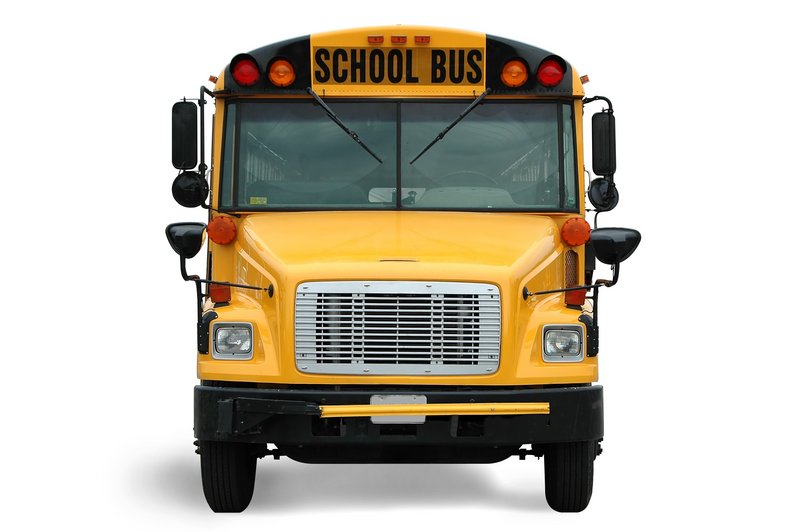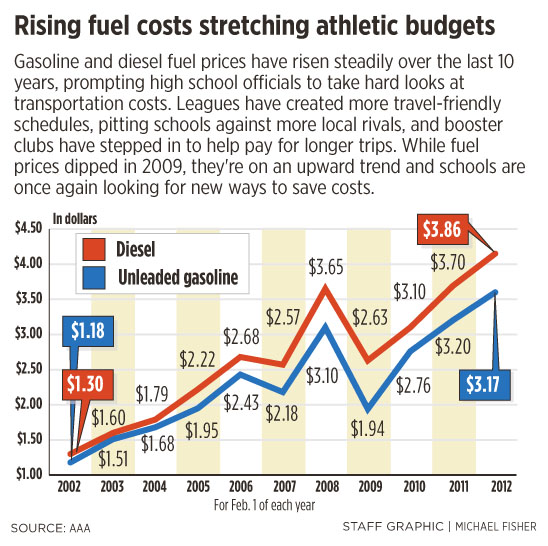Fred Apt got the call in late February. If his Fryeburg Academy softball team — the defending Class B state champs — wanted to continue its annual preseason road trip to Connecticut this year, it was going to have to provide its own transportation.
In the past, Apt’s Raiders would use the school’s mini-buses, which seat about 14 students each. But with the price of diesel fuel and gasoline jetting higher, school officials nixed the use of their buses. Not just for sports, but for any activity outside the immediate area.
“It’s the wear and tear on our vehicles,” said Sue Thurston, athletic director at Fryeburg. “And the price of gas going up.”
Apt understood. And his team’s booster club has stepped up to help rent vans to transport the team to Manchester, Conn., where the Raiders will stay during their trip.
But Fryeburg’s response to increasing fuel costs may become the standard if prices continue to rise. Stretched budgets have already made schools reluctant to send athletic teams long distances without help from booster clubs. If the cost of fuel continues to climb, they may take more drastic measures.
Schedules could be shortened — 16 basketball games instead of 18 — or sub-varsity programs could be cut, depriving districts of the middle school and junior varsity teams that provide students with some of their first opportunities at interscholastic competition.
Schools are already doing what they can to save money. In the past couple of years, they have modified league schedules to play more games against nearby schools. The Maine Principals’ Association has capped the number of non-countable (preseason or exhibition) contests at five per year.
“We’ve been pulling back since 2008, when (fuel costs) spiked over $4 a gallon,” said Ted Welch, athletic director at York High School, which like Fryeburg is located on the outer rim of the Western Maine Conference region. “Our transportation budget was cut 10 percent last year for athletics. And when the cost per trip goes up, we scrutinize trips even more.”
This is the time of year when those costs are under review. Budgets are being drawn up and voted on. This year is especially difficult because of the roller-coaster cost of fuel.
The average price of unleaded fuel in Maine has risen 44 cents since early December, and the price of diesel fuel has increased 25 cents. The price of unleaded fuel had dropped 34 cents in the previous three months, and the price of diesel had risen four cents in the same period, according to AAA.
The increase since December is significant, especially for schools that travel a lot. Van Buren High School in Aroostook County, for example, made two trips to the Bangor Auditorium this year for the Eastern Class D girls’ basketball tournament. Each round trip was about 400 miles. A diesel-powered school bus gets about 10 miles per gallon, so fuel for each trip cost $17 more than it did in December.
School officials are trying to predict which way fuel prices will go — down; moderate; or, as some national groups predict, up another 25 cents — so they can adequately budget their travel.
“It’s very, very hard to predict,” said Dave Powers, the director of maintenance and transportation at Fryeburg. “Who knows what’s going to happen?”
One thing is certain: Given Maine’s passion for high school sports, school officials will do whatever they can to mitigate fuel costs and avoid cutting their programs.
“It’s part of life up here,” said Gehrig Johnson, superintendent of SAD 1, which serves Presque Isle High School. “We’re not going to shortchange our programs or our students. So we just have to plan for it.”
Schools in Aroostook County, such as Presque Isle and Van Buren, carry much heavier transportation costs than those in the southern part of the state. Many schools in Cumberland or York counties have rivals in neighboring towns.
For Presque Isle or Van Buren, that’s not the case.
In the 2010-11 school year, for example, Presque Isle made 550 trips for athletic purposes, according to Johnson (who was, indeed, named after Yankee Hall of Famer Lou Gehrig). Those trips, some of them overnighters, covered a stunning 66,515 miles with an overall cost of $52,400.
“Can you believe that?” asked Johnson.
Presque Isle competes in the Class B Penobscot Valley Conference. Other than Caribou, a mere 13 miles away, the Wildcats travel at least three hours to away games.
“We are voluntarily in the PVC and we know what comes with being there,” said Mark White, the Wildcats’ athletic director. “I worry about our junior varsity contests, about teams coming up here, about our ability to send teams to the Bangor area.
“But my superintendent and school board believe in what athletics is all about, the social values and life skills it teaches.”
White tries to schedule his junior varsity contests as close to home as possible, sometimes playing non-league opponents in other Aroostook County towns. “Our eyes are wide open when it comes to what it means to be up here,” said White. “We know, at least once or twice a year, we have to put up all four teams (boys’ and girls’ teams, varsity and junior varsity) overnight when we go to (Mount Desert Island) and Ellsworth. That’s two buses and hotel rooms.
“It’s expensive, but it goes to our belief that sports is good for the kids.”
“It concerns us,” said Johnson of the escalating fuel costs. “You can tell by the numbers. But it’s a reality we have to live with and there’s no getting out of it. We just try to plan, to anticipate what it’s going to cost us per gallon, and then we budget it in.
“Our philosophy is, we’re up here in Aroostook County but we want the best schedule for our kids and we want to play the strongest competition there is. And we realize we’re going to have to travel to do it.”
At Van Buren, located north of Presque Isle on the Saint John River, travel is only slightly less an issue. The Crusaders compete against other Aroostook County Class D schools, but still regularly travel more than an hour to away games. They’ve cut costs by reducing junior varsity sports — there are no JV teams in soccer and the boys’ basketball JV team didn’t travel — and having the boys’ and girls’ varsity teams travel together and play back-to-back games. But costs are still high.
For small-town teams, that doesn’t bode well.
“If gas prices stay high or keep going up ” said Susan Parent, the Van Buren athletic director. “I don’t know what the answer is.”
Van Buren had some very high costs this year. The girls’ soccer team played in the state championship game in Falmouth, a round-trip of 640 miles at a cost of about $2,000, including overnight hotel rooms, according to Parent. The girls’ basketball team’s two trips to the Bangor Auditorium cost about $450 each, said Parent. “That’s at $4 a gallon for (diesel),” she said.
Those trips deep into the playoffs aren’t always covered in the initial budgets. But, as Parent said, “We’re a small school and we want success. I think the community prides itself in supporting the students. We want to do well.”
The trick, said Nick Raymond, the athletic director at Hampden Academy (which does a fair share of travel being in the northern fringe of the Kennebec Valley Athletic Conference), is to plan accordingly. “You want to plan for each team to make the state championship,” he said. “You don’t want to get to your spring sports and have one team make the state championship and you don’t have the money to send them there.”
Most athletic directors said they have managed to stay within their budgets this year, so they aren’t worried about spring seasons. But they’re still looking for ways to cut costs. Gene Keene, the athletic director at Brunswick, said his freshman teams won’t travel to Bangor. If he can’t replace those games with others against local schools, the schedule is shortened.
Some schools — rivals in many sports — have taken to sharing buses if they have small teams (golf, cheering, for example) going to a common site.
David Maxsimic, the executive vice-president at Wright Express, the South Portland business that provides fueling services for bus and other vehicle fleets, said there is more that schools can do to save costs.
They should first look at how they purchase their fuel — bulk or on a regular schedule — and how their buses are used. There are business tools and applications that can help them find the best price, determine the best time to fill the tank and find ways to get better mileage.
“If you can increase your mileage two to five miles a gallon,” he said, “that will reduce costs quick.”
When making a long-distance trip, said Maxsimic, it’s important to know where you can get the best price for fuel. There are applications that can help you find it.
“When you’re going from Van Buren to Falmouth, you’re not doing it on one tank,” he said. “Knowing the best places to fuel up on the route, or when the best time to fuel up is, could save some money.”
The city of Portland saves a lot of money by using school buses fueled by compressed natural gas. According to Kevin Mallory, the director of transportation for public schools, the city spends 51 cents a mile on diesel buses, but only 27 cents a mile on compressed natural gas.
The city has a fleet of 24 buses, nine of which run on CNG.
“Without CNG, we would have spent a lot more money,” he said.
And in the end, saving money is what everyone wants to do.
That’s why athletic directors will be watching fuel prices closely this summer.
“Hopefully, by the end of the summer things aren’t in more dire straits,” York athletic director Welch said. “I’m already worried. I feel we’re pushing the envelope.”
Staff Writer Mike Lowe can be contacted at 791-6422 or at:
mlowe@pressherald.com
Twitter: MikeLowePPH
Send questions/comments to the editors.





Success. Please wait for the page to reload. If the page does not reload within 5 seconds, please refresh the page.
Enter your email and password to access comments.
Hi, to comment on stories you must . This profile is in addition to your subscription and website login.
Already have a commenting profile? .
Invalid username/password.
Please check your email to confirm and complete your registration.
Only subscribers are eligible to post comments. Please subscribe or login first for digital access. Here’s why.
Use the form below to reset your password. When you've submitted your account email, we will send an email with a reset code.